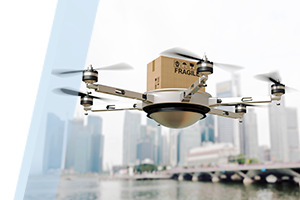
Most of the time I think predicting the future should be left to fortune tellers and meteorologists. But every once in a while it’s fun to think about how the great strides we’re making today could impact our future. We’ve already seen an evolution in things like the telephone, once a novelty shared by entire neighborhoods, now a critical component for businesses and individuals alike. Let’s imagine how supply chains of the future might look in the years to come thanks to the technology changes we’re making today.
How will today’s supply chain innovations and experiments—like autonomous vehicles, drones, and “the Uber approach”—impact the supply chains of tomorrow?
Not So Scary Autonomous Vehicles
You may remember the “Johnny Cab” from Total Recall, or KITT from Knight Rider, but I can assure you that autonomous vehicles are more than a quirky sci-fi concept. In fact in his post last week, Steve Raetz talked about how autonomous vehicles for commercial use are already here, and they’re sure to have a huge impact in the future of supply chains. If you think about it, driverless tractors could be the answer to several of our industry’s largest challenges—from driver shortage to Hours of Service (HOS).
Today autonomous is not yet synonymous with driver-less, but what if it was? If trucks drive themselves in enough lanes, we reduce or even eliminate the driver shortage. HOS becomes a thing of the past—after all a computer won’t get tired driving 3,000 miles in one go—which could reduce delivery times. Carriers could employ fewer drivers, and that may lead to lower healthcare costs, better insurance rates, and less struggle with the driver shortage.
Debate about Delivery Drones
We all know today’s consumers have the “I want it now!” attitude of Veruca Salt from Willy Wonka & The Chocolate Factory. Drones may be the answer.
The one square mile around my house is home to over 60,000 people. Think about how many people order goods online every day in that one square mile alone. Is it half? A quarter? As people’s lives get busier, the convenience of shopping online—especially when fast shipping is an option—will continue to grow in popularity.
Just like autonomous vehicles, the safety and feasibility of unmanned drones delivering goods (primarily small parcel) is still under scrutiny, but implemented the right way, drone technology could significantly reduce traffic congestion, minimize CO2 emissions from trucks idling at the curb while drivers drop off boxes, and improve delivery speed.
Applying Uber’s Approach
Uber and Lyft are probably the best examples of crowdsourcing the transportation of people since the development of public transportation. What if a supply chain ran the same way? John at the dock has freight ready to haul, he pulls up an app on his phone, marks what type of equipment he needs, and gets a list of who’s available in the area and their pricing. He can then select a driver and the truck arrives within minutes. Like drone technology, this may be most effective for home deliveries. Rather than a commercial vehicle driving in and out of neighborhoods, it’s your best friend’s mini-van or the soccer mom’s sedan from down the street. Ultimately I think this technology could cause the most extreme shift from how today’s traditional transportation works.
No matter where today’s technology changes take us, ease of doing business is going to play a monumental role in whatever evolution we see. And I for one look forward to watching technology change and adapt to our supply chain needs.



